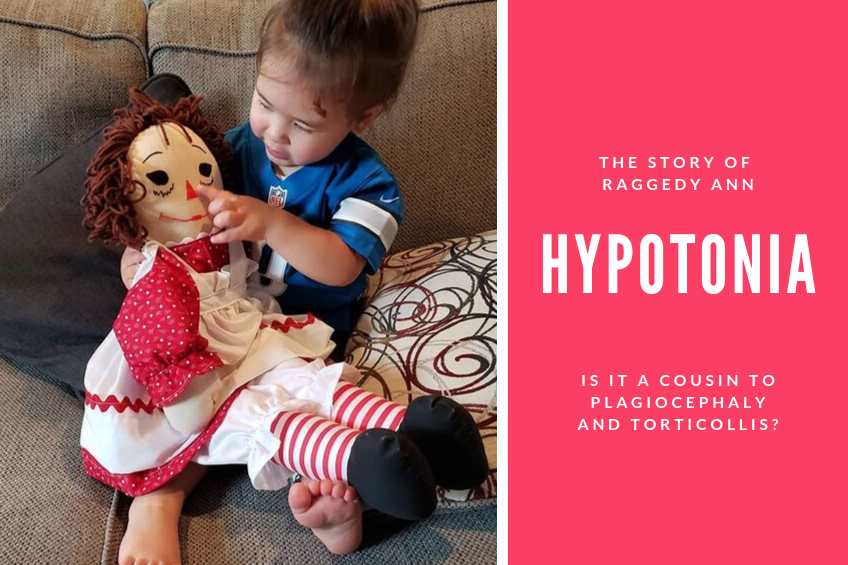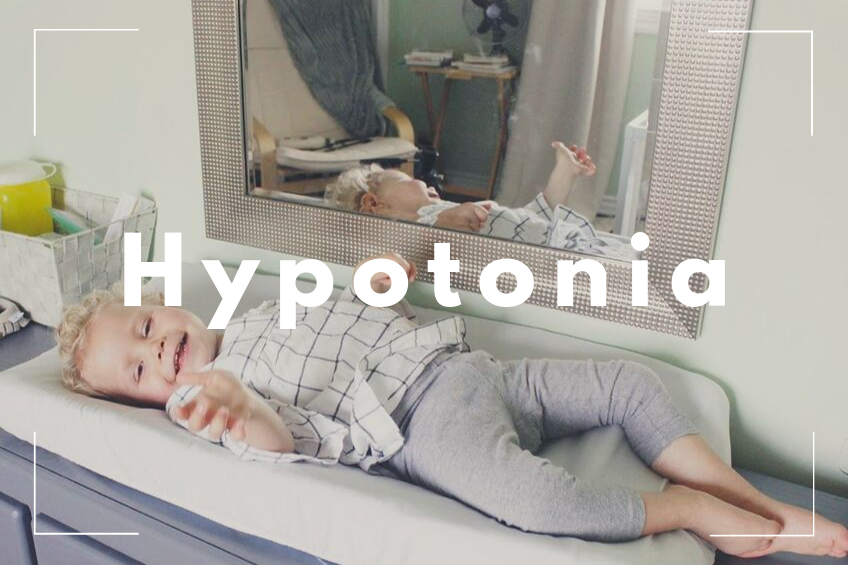Hypotonia | Is it a cousin to Plagiocephaly and Torticollis?
/

Are you old enough to remember Raggedy Ann and Andy Dolls? Surprisingly, these dolls are still available on most toy websites in addition to specific Raggedy doll sites. I do not see them that much in the homes of children today. In fact, I have not seen any of my grandchildren playing with this iconic toy. Raggedy Ann and Andy are characterized by their floppy limbs. For techno – advanced children, there might not be enough stimulation in these stringy playthings.
There are quite a few legends surrounding the story as to how the Raggedy Ann doll came into existence. According to legend, Marcella, the daughter of Johnny Barton Gruelle (1880-1938), found an old handmade rag doll in a storage barrel in her grandmother’s attic. Her father, Johnny, then drew a face on the doll, and named this rag doll, after two poems in a book by James Whitcomb Riley. One poem was called, “The Raggedy Man” and the other, “Little Orphan Annie”. Thus, the name, Raggedy Ann. There are different versions of the emergence of Raggedy Ann which we will leave for a different time.
I thought about the raggedy dolls because of my interest in floppy babies. Hypotonia, or low muscle tone in infants results in your baby feeling like a Raggedy Ann doll in your arms. Floppy babies tend to be difficult to hold since their arms and legs offer no resistance. When an older infant with hypotonia stands on your lap there is no resistance in its floppy legs. This does not always mean that there is a serious problem for your baby’s future coordination and motor development but should be checked out. Just as plagiocephaly and torticollis, need early intervention, hypotonia, should be addressed as early on as possible.

I know of two babies who are now grown up who had floppy limbs, one even not lifting her head for the majority of her first year of existence. In my days of childrearing, going back to the 1970’s and 1980’s, we were not generally instructed by our pediatricians to go for evaluations and therapy. Thank G-d, the babies I knew were lucky and outgrew their floppiness without outside intervention. Of course, today, parents are at a spectacular advantage. They can fairly easily bring their babies for evaluation for various different muscle and head problems, like, torticollis, plagiocephaly, and hypotonia.
How is Hypotonia diagnosed?
Infants who are born prematurely, toddlers who are late walkers, or fall often, babies with poor sitting posture or general floppiness, are considered to have low muscle tone.
How do the muscles work?
A muscle fiber is held in place by a connective tissue something like a sleeve. Groups of muscle fibers and the individual muscle are also enclosed by a connective tissue sleeve. Usually, there is a small amount of give in the connective tissue of muscles and tendons. In a baby with low muscle tone, the connective tissue is less stiff with more give. Muscles when touched will feel softer than normal muscle tone. This can be compared to a baseball player who injured his ankle and is instructed to stay off his feet for several weeks. Amazingly his muscles will atrophy, and he will need massive physical therapy sessions to build up those loosened muscles.
Why do premature infants have poor muscle tone?
Full term babies have the advantage of curling up in their mother’s womb for the full term to develop the right amount of muscle stiffness. Preemies have missed the correct amount of time curling up in the womb and so their muscles appear to be floppy and weak. You can notice their floppiness when you see these babies lying with their arms and legs extended as well as having less movement than full term infants. The fetus in the womb is quite active. Kicking, stretching and even turning are activities which strengthen their muscles before birth.
How does Hypotonia affect a baby’s sitting, standing and late walking?
Surprisingly, a toddler with low muscle tone can have some tightness in its hip muscles which will affect his or her ability to sit upright. If the toddler’s leg muscles are weak, he can trip, fall and will not like to walk distances.
Fine motor functions, such as picking up small objects, will be affected if there is hypermobility in the hands. These physical delays can be mistaken for an over cautious nature in a baby. I have had this personal experience with one of my own children. This child, who is incidentally quite bright and a very good ball player as a teen, did not walk by himself until he was eighteen months old. Yes, he did have a cautious nature, however, now I am wondering is perhaps his fear of letting go had to do with low muscle tone. Therefore, it so important to have your baby evaluated early and not play guessing games.

How can we determine if the baby has active muscle tone?
A muscle must automatically be ready for action. This is ascertained by the amount of contraction in a muscle’s intrafusal fibers, which in turn will set the sensitivity of the stretch of the part of the body. An infant or toddler who is alert and engaged, will be ready for action automatically and its muscle tone will increase instantly, in preparation for movement.
What are the treatments of Hypotonia or low muscle tone in babies?
The first step is to have your baby evaluated on the extent of his or her condition. If your baby’s condition is mild, you will be able to work at home to strengthen his or her muscles. The exercises are really the same as for plagiocephaly flat head syndrome and torticollis (crooked neck).
Blanket Swaddling
Here’s how to become an expert baby swaddler. Swaddling is an ancient art that was an integral part of infant care. Swaddling is the art of snugly wrapping a baby in a blanket. In ordinary cases, this is done to give the baby security by imitating the snugness of the womb.
In the case of floppy limbs, the therapists at St. Mary’s Hospital in Madison, Wisconsin, believe that swaddling gives you baby something to resist against. For directions on how to swaddle your baby correctly check out the video below. Remember to keep your baby’s nose and mouth clear of the blanket to avoid danger of suffocation.
Tummy Time
Infants with low muscle tone will not willingly spend time on their tummies. Some infants with floppy limbs, find it difficult to get up on all fours, especially if they have hypermobile elbows and a tendency to keep their legs wide apart. Try placing your baby with his or her head to one side and lure him or her with noises and toys. This movement will increase the baby’s head and neck muscle tone.
Encourage independent sitting and crawling
Using your common sense for age appropriateness, motivate your baby with assorted exercises. Some babies sit, stand and crawl on their own, however, a baby with mild hypotonia will need the parent to help.
Mommy and Baby Water Workouts
Venues such as, Oh Baby Fitness, offer aquatic programs for babies and toddlers together with moms. Their aquatic class is action packed letting you exercise in the water with your baby at your side. At this location, a certain amount of baby head control is necessary. The babies range from fifteen pounds to twenty-four months of age. Of course, babies are given flotation seats. Search for other establishments that cater more to the baby’s muscle strengthening. Some places may have both, for baby and for mom.
Monitor your baby’s progress by a professional
Always, consult with your pediatrician on a regular basis to assess your baby’s progress. Your doctor may recommend a meeting with a physical therapist so that you can learn new and additional exercises to do at home.
Final Words
A lot of the time, parents can help their baby with hypotonia. Sometimes, a couple of visits to a competent physical therapist will ease the parent’s task of tummy time, swaddling and general exercising so that these tasks will become routine. Don’t worry. By following the above prompts, the only Raggedy Ann you will have will be the one in your child’s toy chest.

Cranial Therapy Centers is the only early interventions cranial center in the United States which provides both helmet and manual therapy treatment. We are American Board for Certification in Orthotics, Prosthetics and Pedorthics Facility. Visit us in Lakewood NJ, at 1352 River Ave Unit 14, Lakewood NJ, 08701 or in Teaneck NJ at 1086 Teaneck Road Suite 3F, Teaneck, NJ 07666. You can also email us info@cranialtherapycenters.com
